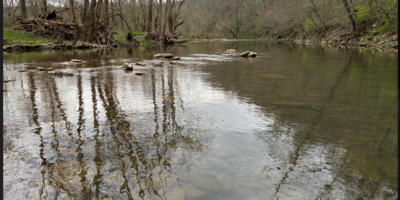Learning from Eagle Creek and Jeff Biggers
By Herbert Reid
Jeff Biggers is right. All of us, every living being on planet Earth, have entered the age of climate destabilization and now live in the coalfields. Most scientists agree that the main source of emerging climate problems is the soot and carbon dioxide from burning oil and coal. As climate scientist Will Steffen put it in 2005: Before, if we screwed up, we could move on. But now we don’t have an exit option. We don’t have another planet.” We need to understand coal’s central role in our clean-energy challenge and the urgency of finding paths of transition to what Biggers calls a coal-free future. Check out his powerful book Reckoning on Eagle Creek: The Secret Legacy of Coal in the Heartland (New York: Nation Books, 2010).
The book’s introduction begins with the words of a well-known coal state politician, Barack Obama. Campaigning for the Democratic presidential nomination in 2008, Senator Obama recommended a fast-track for “clean-coal” technology and proclaimed the USA “the Saudi Arabia of coal.” The next year as President, Mr. Obama repeated the phrase but also noted that this “cheap energy source … creates a big carbon footprint.”
Big Coal or what I sometimes call our Fossil Fuel Sector has made the propaganda of clean-coal familiar to every Kentuckian, often with a derogatory view of the science of climate change. In Kentucky the industry also attempts to popularize the view that because electricity is “cheap “everyone profits from coal. Members of Kentuckians for the Commonwealth such as Teri Blanton working with its “Canary Project” have provided a different accounting of costs reinforcing the agenda of a renewable energy future.
Jeff Biggers also wants his readers to grasp that coal has not been “cheap.” He invites the President to get out of his tourist entourage and take a more serious and historically grounded look at our “Saudi Arabia of coal.” As Betsy Taylor and I put it in our new book on recovering the commons, “to trot the globe is not to inhabit a world.” Biggers challenges the President and many others to move beyond the all too familiar resource object image. Reckoning at Eagle Creek restores coal’s real world of economics, politics, and historical change—and the human and ecological ruins left behind. These are “externalities” only in the unworldly calculations of an economics unable to acknowledge the practices of sustainable communities.
In many ways, the Biggers family homestead on Eagle Creek in southern Illinois, known since 1849 as the Oval Hill Farm, operates as the focal place of this remarkable study. Oval Hill serves as a tangible reminder that footprints, even and especially carbon footprints, make imprints on the land, its people, their pasts and futures. The prologue ends as Jeff recalls his mother and uncle, standing in the midst of Oval Hill’s ruins, detecting a remaining patch of corn “growing out of the rubble in defiance of the strip mine” that replaced the farm.
The cultural geography in the vicinity of Eagle Creek carries names such as the Shawnee Hills, the Shawnee National Forest, and Shawneetown. Assisted by Shawnee activist Barney Bush and others, Jeff probes the ruins, as it were, of the Great Salt Spring. (It has been said that the French Revolution was sparked in part by a salt tax. In any case salt as a food preservative has been important to the human diet).
By 1836, Biggers notes, “coal had increasingly replaced wood as the main fuel” at the furnaces extracting salt around Eagle Creek. His work revives submerged stories of the removal of Native Americans and the work of both black and Indian slaves in Illinois of the 1700s. What he refers to as “the entangled roots of slavery and coal” are shrouded in historical silence(s) and not as easily unearthed as you might think. His study weaves in contributions from Appalachian scholars such as historian Ron Lewis. Biggers helps the reader’s appreciation of complementary developments, e.g. between southern Illinois and the Kanawha River Valley of West Virginia.
Utilizing critical ideas from social theorists concerning power, history, and culture, the middle chapters forge an engrossing historical narrative of the politics of work that connects slave labor to the battles over unionization in the 20th century. Biggers shows that while slavery was an issue along Eagle Creek, in the decades after the Civil War such matters were often subjected to erasure or trivialization. One aspect of Jeff’s reclaiming of Eagle Creek’s history is his redemption of “the secret knowledge of the old-timers.”
As Biggers is well aware, there are other connections with Appalachian history and politics. The destruction of our “Eagle Creeks”—wherever they are and however it is done—bereaves us all. Their loss is registered in the pollution of the Atmospheric Commons on which the human habitability of the Earth depends. Wendell Berry has been telling us for years that the notion some can do anything they want without drastic consequences for everybody is colossal stupidity.
I once stood with Leslie County’s Daymon Morgan on the pathetic stump of a mountain strip-mined 25 years earlier overlooking what remained of a mountain still being plundered by the more drastic methods of “mountaintop removal.” The appalling vista brought to mind the farcical promises of “regulation” for “environmental protection” of state governments as well as state institutions of higher learning and their centers for “clean coal research.” In such unbearable situations we have to find inspiration and courage from the example of citizen activists such as Daymon Morgan and Teri Blanton. In Recovering the Commons, Taylor and I discuss the Appalachian citizen action groups that in our experience demonstrate the arts of reweaving mourning and memory counteracting political passivity and the cultural acquiescence sought by corporate power.
John Prine’s song of many years ago about “Paradise” in Kentucky’s Muhlenberg County is still popular, the lyrics well-known. Well, Mr. Peabody’s coal train began in Illinois and Biggers gives us the rest of the story. In fascinating detail, Bigger shows how that story starts well before Peabody Mine No. 1 was sunk in 1895 in southern Illinois one county over from Eagle Creek. This book by Biggers offers valuable historical perspectives on what has become Peabody Energy, probably one of the most powerful entities ever operating in American politics and public policy.
It will not be as easy to abolish mountaintop removal (MTR) as some think. And phasing out stripmining in general and implementing a just transition for the coalfields as part of a national clean energy economy based on green jobs will be even more of a struggle. We will have to recognize, as does Biggers, the extent to which existing programs for regulation and reclamation are leaving not only terrible scars on land and habitat but also are reinforcing strong political tendencies toward various forms of amnesia. One of the questions Biggers and several of us are asking now after the TVA disaster in Tennessee: why is it so easy to forget or ignore that half of Americans live within an hour of a toxic coal ash dump?
Then there is that carbon footprint that somehow coexists in the President’s mind with “clean coal”! The political problem, certainly not his alone, is how and when more of us will start listening to what Jeff calls “the silent volcanoes of climate destabilization”? Across this planet, the children of today and their children of tomorrow depend upon people, politicians and businesses making stronger moves now toward sustainable policies than many of us have begun to imagine. In the last fifty pages of his book, Biggers makes clear why he thinks WV Congressman Ken Hechler was right when in the 1970s he spoke for the movement to abolish surface mining. I fear that the memory of that movement in recent years has gotten shaky and confused. I am one of those who thinks the Appalachian Alliance of 1977 was right to call for a Jimmy Carter veto of the legislation that established the Office of Surface Mining. This book bolsters that case.
Why read this book? We have just learned during the past week of a Pulitizer Prize in General Non-Fiction for David E. Hoffman’s book The Dead Hand: The Untold Story of the Cold War Arms Race and its Dangerous Legacy. It is encouraging to see such a book dealing with a momentous issue winning the prize. In my opinion, Reckoning at Eagle Creek is a book of this caliber and, hopefully, in the year ahead will become a contender for the same award.
Hear Jeff Biggers in Lexington on Monday, April 19, 7 PM, at UK’s Student Center Worsham Theater.




Leave a Reply